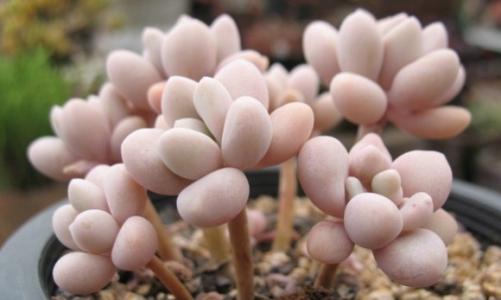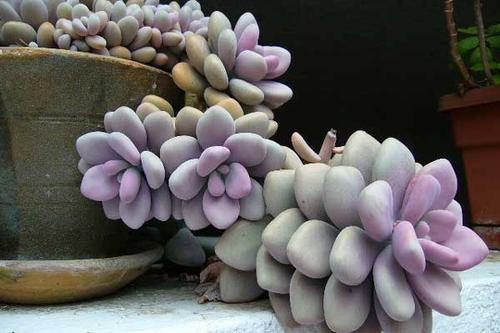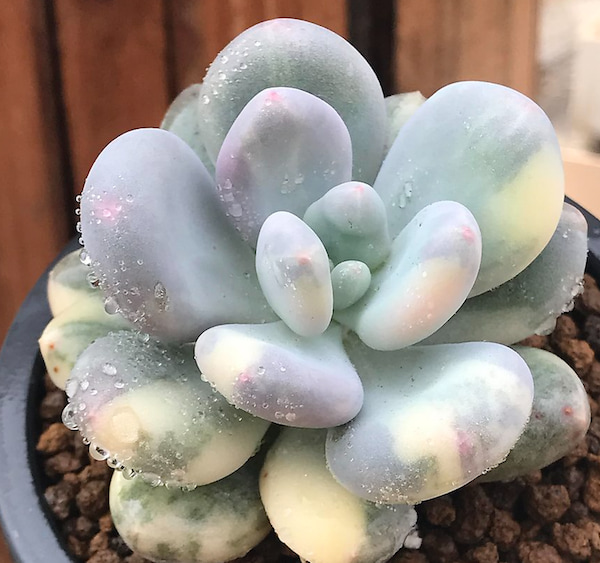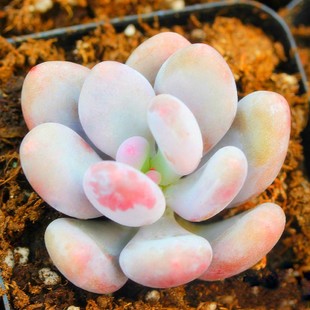Moonstone Succulent (Pachyphytum Oviferum) Profile: Plant Info & Care Guide
Written by Maggie
Dec 07 2021

The Moonstone succulent, scientific name Pachyphytum oviferum, is a branch of the Moonstone succulent plant family and a horticultural species of star beauties, with which the two are often confused. Moonstone Succulent has pink leaves, which are round and plump.
Moonstone Succulent Picture

Moonstone Succulent Morphological Characteristics
This pink Moonstone succulent has a short stem. The leaves of Moonstone succulents are arranged in the shape of lotus, fleshy, oval, oval, pointed, with a little pink.
Moonstone Succulent Ecological Habits
Moonstone succulent enjoys a sunny tropical environment with annual minimum temperatures above 5° C.
How to Propagate Moonstone Succulent
Moonstone Succulent Propagation from Leaf-cutting
Cut leaves from healthy Moonstone succulent during the growing season, ideally not watering them two days before cutting. Put in a cool environment for a few days, after being slightly dry, namely in the basin of sand, need not be inserted into the soil, it is OK to put the leaf flat. Less water or not watering, keep basin sand moist, easy to root survive. When the Moonstone succulent roots are two to three centimeters long, transfer them to small pots and grow. Branches or leaves can be inserted, the leaf is better.
Moonstone Succulent Propagation from Cuttings
Cut off 2-3 layers of leaves from the bottom of the Moonstone succulent (Pachyphytum Oviferum). Remove the redundant leaves and use them for leaf insertion. The number of main leaves in-branch insertion is reduced, which is more conducive to re-rooting and reproduction. The head was inserted into the soil to root after the Moonstone succulent plant wound had healed. No watering, no sun exposure. Or directly placed in a glass bottle with a fine mouth to root, clean enough to observe the rooting of the moonstone succulent plant.

How to Grow and Care for Moonstone Succulent
Moonstone Succulent Watering Care
Moonstone succulents are flowers that shop water in their thick, rubbery leaves, stems, and roots. moonstone succulents are tailored to do this due to the fact they are native to hot, dry, arid areas the place rainfall can be scarce for lengthy durations of time, and storing water and vitamins allows them to survive. Interestingly, Moonstone succulent will certainly show up swollen when storing water.
This is a gain for you as a gardener if you're busy, or have different flowers that require greater regular attention, as Moonstone succulent plants want time for their soil to dry out between waterings, and do fantastic when left to use all of the water you have already given them.
It is vital to make certain you do no longer overwater Moonstone succulent plants (Pachyphytum Oviferum) due to the fact when their roots sit down in the water for too long, Moonstone succulents are in all likelihood to improve root rot and die. Make positive the soil has dried definitely before watering. Touching the topsoil can let you comprehend if it's had enough time to dry. Make positive it is dry a couple of inches down into the soil earlier than you provide your Moonstone with any other drink.
Another way to inform whether or not or no longer your Moonstone succulent wants to be watered is by using checking its leaves. If Moonstone succulent plant leaves sense firm, its capability it doesn't want to be watered yet. If they're soft, deflated, or shriveled it capability it's watering time.
When watering your Moonstone succulent, keep away from permitting the water to contact its leaves and go so deep into the soil. This will assist forestall your Moonstone succulent leaves from being damaged, or opening to rot and will enable extra water to run out of the drainage hole.
Another factor to preserve in thinking when it comes to watering your Moonstone succulent plant is that it will want to be watered greater often in the winter, as that is its developing season. This is something that is of greater precision to the Moonstone succulent plant and is no longer real of all succulents.

Moonstone Succulent Temperature & Light Care
Moonstone succulent can be grown indoors or outdoors, however there are sure temperatures, lighting fixtures and environmental prerequisites that these flowers prefer.
Whether interior or outside, Moonstone succulent thrive when positioned in a sunny spot. If you hope to maintain your Moonstone succulent inside, be positive to the area it close to a sunny window, or beneath a developed light. If including one to your out of doors garden, pick an area that receives full solar year-round. But, if the vicinity the place you stay experiences intensely warm summers, area your Moonstone succulent in a spot that receives color in the afternoon to assist defend it from too much severe solar exposure. While your Moonstone succulent leaves are lined in a powdery layer of farina for solar protection, there is no want to over expose them and threat damage.
Ideally, Moonstone succulent choose hotter temperatures (65-80°F) and low humidity, which makes them flawlessly acceptable for a sunny spot in your home. However, Moonstone succulent can't live to tell the tale in temperatures under 20°F. If you select to add a Moonstone succulent to your out of doors backyard and you stay in a region the place winters have temperatures at or beneath freezing, you want to cowl it with a sheet or blanket, or go it internal to shield it from these low temperatures.
When Moonstone succulents ride a shock, such as a severe temperature change, or a lack of or extra sunlight, they may additionally “blush” or flip an exceptional color. Moonstone succulent plant leaves may additionally emerge as extra rectangular or trade structures as Moonstone succulents develop in the direction of the sun. If you are hoping to hold the equal form and color of your Moonstone's leaves they had when you procured them, you will prefer to flip them as they regulate closer to the daylight and to shield them from experiencing a shock.
Soil for Moonstone Succulent
The soil you use to re-pot your Moonstone succulent (Pachyphytum Oviferum), or to plant it outside, is one of the most essential components of your Moonstone plant's care. While they might also be slow-growing and require minimal care elsewhere, Moonstone succulent are precise with necessities when it comes to choosing a soil. The key is for you to buy or create a soil that is loose, gritty, nicely draining, and affords expert aeration. Aeration permits air, water and vitamins to penetrate your Moonstone succulent's roots. Again, if water is trapped inside sticky, compact soil and the roots continue to be moist for too long, Moonstone succulents run the danger of creating root rot or a fungal disease, which can lead to your Moonstone plant's death.
If you are searching to buy pre-made potting soil, use a nicely draining cactus and succulent plant soil with 50% to 70% mineral grit such as coarse sand, pumice, or perlite. The motive of pumice or perlite is to resource in aeration and drainage. If you desire to create your own, you have extra than one choice when it comes to substances you can mix. A combination that has proven to yield gorgeous effects is sand, perlite/pumice, and everyday potting soil. An exceptional mixing ratio of these three components is two components sand, two components gardening soil and one part perlite or pumice. This interprets to three cups of sand, three cups of soil and one and a 1/2 cups of perlite or pumice. Another combination you can make is one of compost and sand.
Be certain to use a gorgeous soil combination when re-potting your Moonstone succulent plant after purchase, if it outgrows its container, or if you are planting it outside. If planting Pachyphytum oviferum outside, combine equal components of compost with sand or pumice, and fill in the location of the place you design to plant it to a depth of 10-12 inches. If you are repotting your Moonstone plant, it is additionally really useful that you do so all through wintry weather and that you replant the stem to the equal depth that it was once planted in its preceding container.
Growing Moonstone Succulent in Pots
One of the most attractive elements of developing Moonstone succulent (Pachyphytum Oviferum) is that they require minimal house and can without problems thrive when planted in a pot. This can be executed due to the fact Moonstone succulents will continue to be particularly compact, although Moonstone succulents can unfold to 12 inches wide. One of the blessings of planting Moonstone Succulents in a pot is that they can be moved internally and outdoor easily, and that Moonstone Succulents can be moved around internal to somewhere Moonstone succulents can acquire ample daylight or be underneath a developed light.
When growing your Moonstone succulent in a pot, make positive your pot has drainage holes and that the moonstone plant itself sits above the pot's rim. If your Moonstone succulent plant is too a long way beneath the rim, water can pool, and rot your leaves. Which, as you can imagine, would now not be gorgeous for the fitness of your Moonstone succulent. It's ok to plant extra than one succulent plant in an identical pot, however, planting them extraordinarily shut collectively can make watering your Moonstone plant life difficult. Leaving a small quantity of house between them encourages your flora to develop larger, and makes watering the flora a bit easier. However, when there's too much house between them, the Moonstone succuelnt plant life has a tendency to continue to be the equal dimension and devote extra of their electricity to developing their roots. If you diagram a location greater than one plant in the equal pot, I motivate you to strive to put a small quantity of area between every plant.
Moonstone Succulent Distribution Area
Moonstone succulent (Pachyphytum Oviferum) is a native of Mexico and is grown worldwide.
Moonstone Succulent Uses
Moonstone succulent (Pachyphytum Oviferum) is used for gardening potted ornamental, edifying temperament.

Latest Updated
- Benefits of Bugleweed - 7 Science-backed Health Benefits
- Bugleweed Dangers & Side Effects - Is It Poisonous?
- How to Plant Evergreen Trees - What You Should Know
- When to Plant Evergreens - Grow Guide for Evergreen Trees
- 12 Wonderful Evergreen Shrubs for Your Garden
- 12 Popular Evergreen Plants with Pictures for Beginners
- When And How To Prune A Lilac Bush Like a Pro
- How to Grow & Care for Lilac Vine (Hardenbergia Violacea)
- Japanese Lilac Tree (Syringa Reticulata) Care & Propagation Guide
- Shumard Oak Pros and Cons - What to Know
Popular Articles
- Winter maintenance of Antirrhinum Majus
- How to Grow Terminalia Mantaly Tree
- How to Grow and Care for Crossostephium Chinense
- How to grow Antirrhinum Majus in spring
- Peristeria Elata (Dove Orchid) Profile: Info & Care Guide
- Underwatered Snake Plant (Sansevieria Trifasciata) - Signs And How To Fix
- How to Care for Brazilian Jasmine Plant (Mandevilla Sanderi)
- How to Grow & Care for Graptopetalum Purple Delight in Summer
- Rosa Chinensis (China Rose): Plant Growing & Care Tips
- How to Care for Baby Sun Rose (Aptenia Cordifolia)